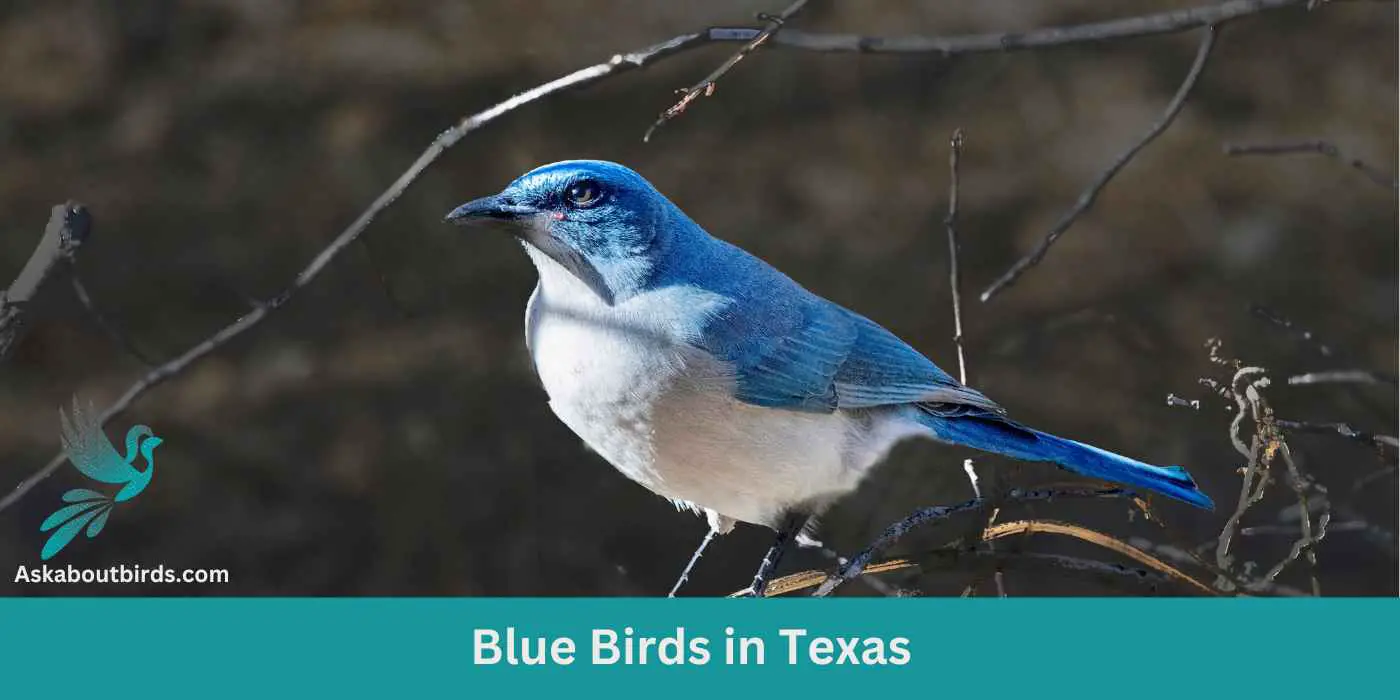Welcome to the ultimate guide for birdwatching in the Lone Star State! Texas, with its vast and varied landscapes, is home to a spectacular array of wildlife, including a variety of beautiful blue birds.
From the Eastern Bluebird to the Indigo Bunting, the blue birds of Texas are a sight to behold. In this guide, you’ll find a comprehensive list of blue birds found in Texas, along with a FREE photo guide to help you identify and appreciate these magnificent creatures in their natural habitat. Grab your binoculars, download your photo guide, and let’s embark on a birdwatching adventure in Texas!
Blue Birds Found In Texas
Texas’ geographical diversity is a birdwatcher’s paradise, offering a wide range of habitats for different bird species. From the arid deserts of West Texas to the piney woods of East Texas, the coastal wetlands along the Gulf of Mexico to the grassy plains in the Panhandle, each region provides a unique environment for various bird species, including an array of beautiful blue birds.
This biodiversity is further enriched by Texas’ location along major migratory routes, making it a critical stopover for birds with beautiful blue feathers traveling between North and South America. This mix of resident and migratory birds contributes to the vast and diverse breeding range and population of birds found in the state.
Eastern Bluebird
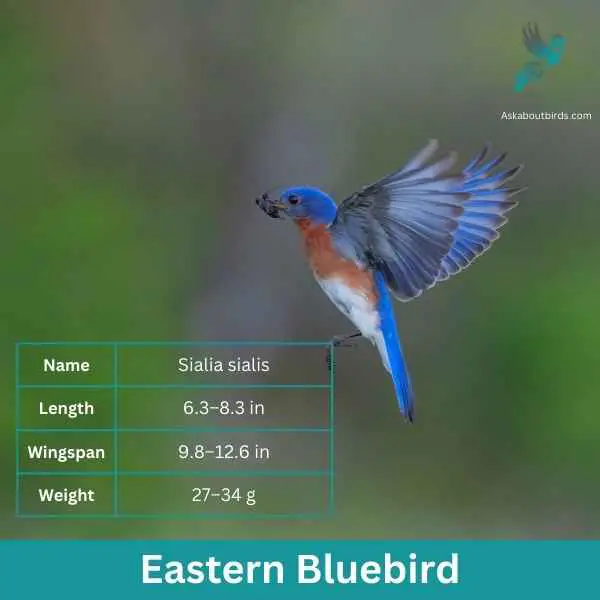
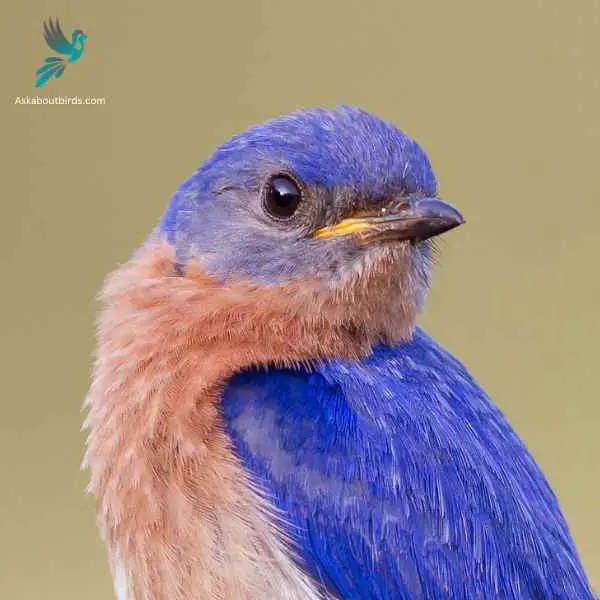
| Feature | Measurement |
|---|---|
| Scientific Name | Sialia sialis |
| Length | 6.3–8.3 in |
| Wingspan | 9.8–12.6 in |
| Weight | 27–34 g |
The Eastern Bluebird (Sialia sialis) is a small thrush found in open woodlands, farmlands, and orchards, and is recognized for its vibrant blue and red coloration. Male Eastern Bluebirds are dazzling with bright blue upperparts and a rusty or brick-red throat and breast, while females, though less colorful, still offer a similar pattern. The bird is native to North America and is commonly seen east of the Rockies, from Canada to the Gulf States and southeastern Arizona to Nicaragua.
Eastern Bluebirds feed on insects, wild fruit and berries. They have a gentle nature and are often seen perched alone or in small groups in the open, scanning the ground for prey. They are cavity nesters and will use old woodpecker holes or birdhouses if they are the right size.
Blue Jay
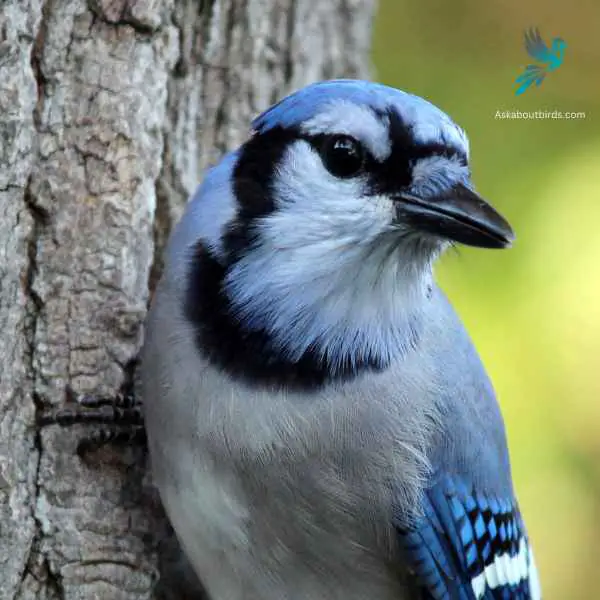
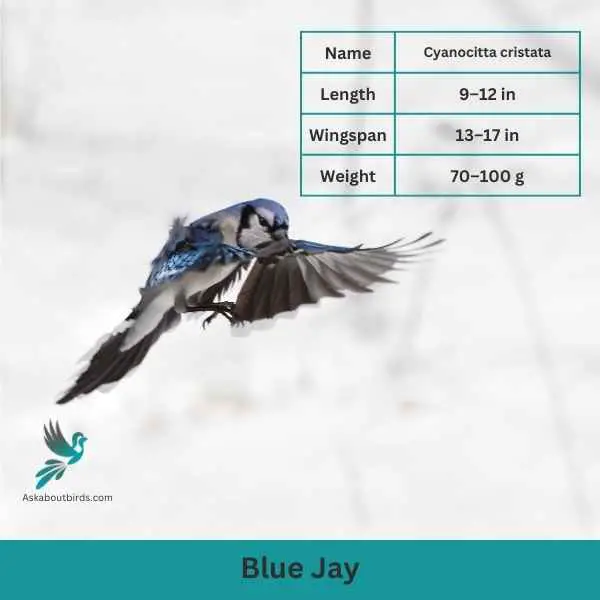
| Feature | Measurement |
|---|---|
| Scientific Name | Cyanocitta cristata |
| Length | 9–12 in |
| Wingspan | 13–17 in |
| Weight | 70–100 g |
The Blue Jay is a vibrant and easily recognized bird, known for its intelligence, distinctive calls, and bold behavior, commonly found throughout the eastern and central United States.
Appearance: The Blue Jay sports a striking blue upper body with white and black markings. Its face has a pronounced white patch with a black necklace that runs across the throat and around the head. The bird also features a pronounced blue crest, which can be raised or lowered, and its wings and tail are brightly colored with black bars and white tips.
Diet: Blue Jays are omnivores. Their diet consists primarily of seeds, nuts, especially acorns, fruits, and small insects. They’ve also been known to eat eggs or nestlings of other birds occasionally. Blue Jays often store food items in caches to eat later.
Reproduction: Blue Jays are monogamous birds that form long-lasting pair bonds. They typically build their nests in trees or large shrubs, constructing them from twigs, grass, and sometimes using mud as a binder. The female lays a clutch of 3 to 6 eggs, which are pale blue or sometimes white with brown speckles.
Western Bluebird
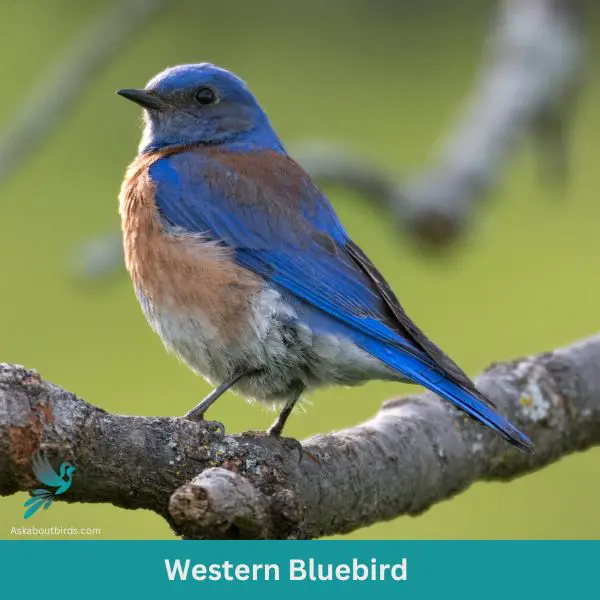
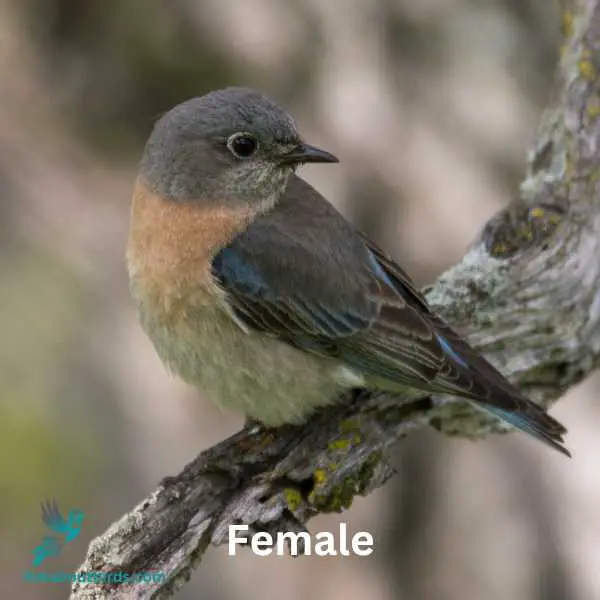
| Trait | Western Bluebird |
|---|---|
| Scientific Name | Sialia mexicana |
| Length | 5.5-7 inches |
| Wingspan | 11-13 inches |
| Weight | 0.8-1.1 ounces |
The Western Bluebird is a charismatic bird, appreciated for its vivid coloring and melodious song, commonly observed in open woodlands and meadows of the West.
Appearance: The male Western Bluebird sports a dark blue head, throat, wings, and tail with an orange breast and sides, transitioning into a grayish belly. Females are more muted, displaying grayish-blue wings and tail with a more subdued orange wash on the chest.
Diet: Western Bluebirds predominantly feed on insects, complemented by berries and fruits when available. They hunt by perching and then diving to the ground to capture their prey, and they’re also known to catch insects in mid-air.
Reproduction: These birds often utilize natural tree cavities or nest boxes for breeding. The female builds a loose nest inside and lays a clutch of 4-6 pale blue eggs.
Mountain Bluebird
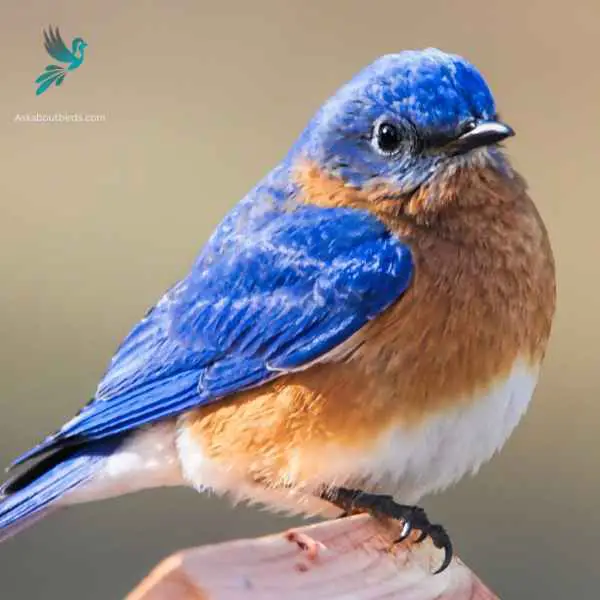
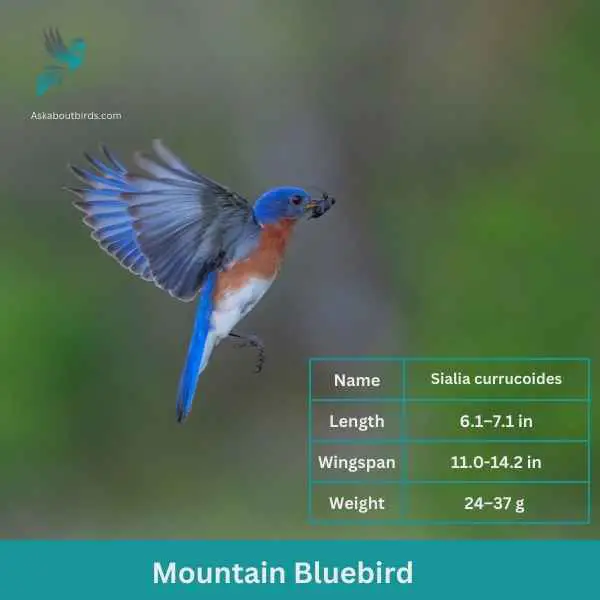
| Feature | Measurement |
|---|---|
| Scientific Name | Sialia currucoides |
| Length | 6.1–7.1 in |
| Wingspan | 11.0-14.2 in |
| Weight | 24–37 g |
The Mountain Bluebird is a small bird found in open grasslands and rocky mountains of North America. It is known for its stunning blue plumage, which is particularly vibrant in males. Females, on the other hand, have a more subdued blue coloration with hints of gray. These birds have slender bodies and a slightly curved bill, adapted for catching insects on the wing.
Mountain Bluebirds are insectivores, feeding primarily on insects such as beetles, grasshoppers, and spiders. They are skilled aerial hunters, capable of capturing their prey in mid-flight. During breeding season, these birds build their nests in tree cavities or man-made nest boxes, where females lay a clutch of eggs. The male bluebird actively participates in nest-building and provides food for the female during incubation.
Western Scrub-Jay
Scientific Name: Aphelocoma californica
Length: 11.5-12.2 in (29-31 cm)
Wingspan: 15.0-16.1 in (38-41 cm)
Weight: 2.8-3.5 oz (80-100 g)
The Western Scrub-Jay is a medium-sized, intelligent bird known for its bold behavior and striking blue-and-gray plumage.
Appearance: Both male and female Western Scrub-Jays have a similar appearance, featuring a blue head, wings, and tail, a grayish-brown back, and a pale gray underbelly. The throat is white with a blue necklace.
Diet: The diet of the Western Scrub-Jay is quite varied, consisting of insects, fruits, seeds, and nuts. They are also known to eat eggs and nestlings of other birds as well as scraps of human food.
Reproduction: Western Scrub-Jays typically nest in trees or shrubs. The female builds the nest and lays a clutch of 3 to 6 eggs, which are pale green or bluish-green in color. The female incubates the eggs and takes the lead in feeding the chicks, although the male may assist in feeding as well.
Mexican Jay
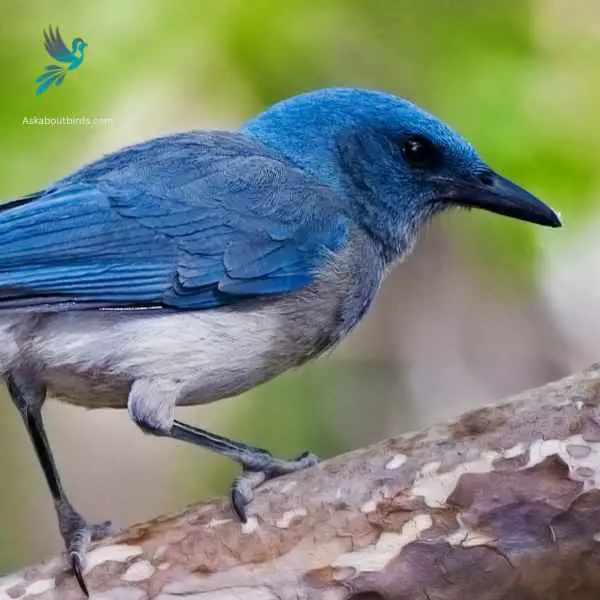
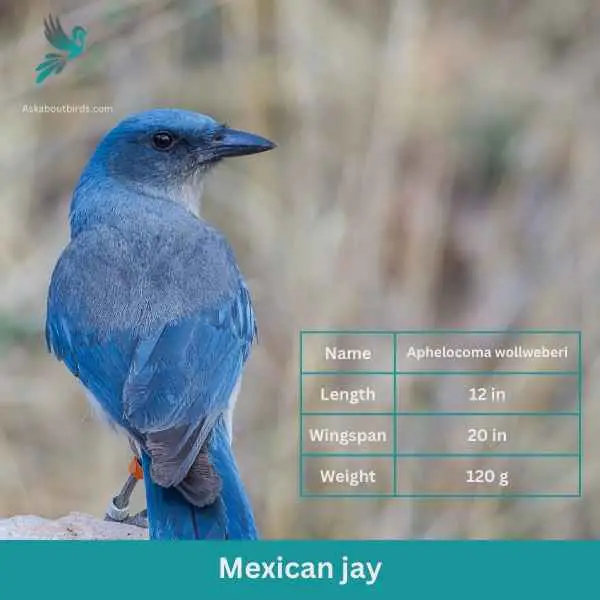
| Feature | Measurement |
|---|---|
| Scientific Name | Aphelocoma wollweberi |
| Length | 12 in |
| Wingspan | 20 in |
| Weight | 120 g |
The Mexican Jay, native to the southwestern United States and Mexico, is a charismatic and intelligent bird known for its vibrant appearance and social behavior. With a striking combination of blue, black, and white feathers, it stands out amidst the arid landscapes it inhabits. Mexican Jays are medium-sized birds with a robust build and a crest on their head, adding to their distinctive charm.
These birds are highly social and often form large flocks that engage in cooperative behaviors such as mobbing predators or foraging together. They have a wide-ranging diet, including seeds, fruits, insects, and even small vertebrates. Mexican Jays are also known for their remarkable vocalizations, which consist of a variety of calls, including raucous squawks and melodious notes.
Indigo Bunting


| Feature | Measurement |
|---|---|
| Scientific Name | Passerina cyanea |
| Length | 4.5–5.1 in |
| Wingspan | 7.1–9.1 in |
| Weight | 11.2–21.4 g |
The Indigo Bunting is a strikingly vibrant songbird, often hailed for its brilliant blue plumage and melodic song that graces woodlands and meadows during the warmer months.
Appearance: Males are renowned for their bright indigo blue feathers, which can appear darker in certain lights. Females and juveniles, on the other hand, are brown with subtle hints of blue on their wings and tail. The species lacks the vibrant streaking or spotting commonly found in many other songbirds.
Diet: Indigo Buntings primarily subsist on seeds, especially during non-breeding seasons. During the breeding season, they also consume a variety of insects such as beetles, caterpillars, and spiders, providing essential protein for their growing chicks.
Reproduction: Indigo Buntings build their nests close to the ground in shrubs or low tree branches. These nests, crafted meticulously with grasses and other plant materials, cradle clutches of typically 3 to 4 eggs. After hatching, the young are fed by both parents until they’re ready to fledge.
Lazuli Bunting
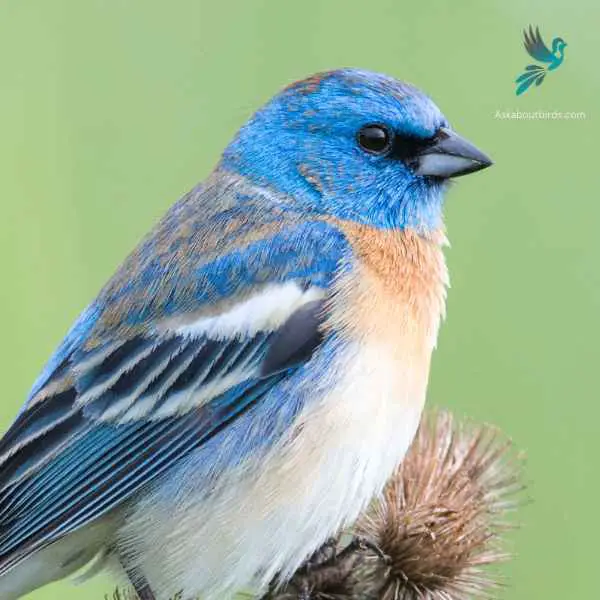
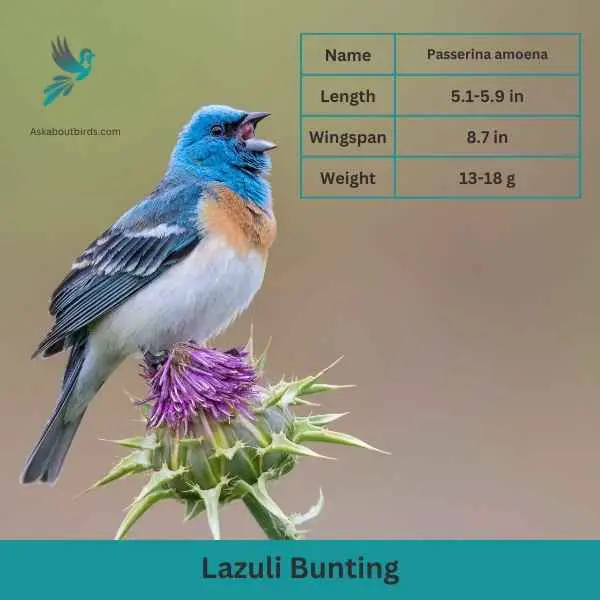
| Feature | Measurement |
|---|---|
| Scientific Name | Passerina amoena |
| Length | 5.1-5.9 in |
| Wingspan | 8.7 in |
| Weight | 13-18 g |
The Lazuli Bunting is a vibrant songbird recognized for its brilliant colors and melodious song, frequently seen in brushy areas and woodlands during the summer months.
Appearance: The male boasts a dazzling bright blue head and back, offset by a white belly and rust-orange breast. Females and immature birds present a more muted brownish hue overall, with a hint of blue on the wings and tail.
Diet: Lazuli Buntings primarily feed on seeds, but during the breeding season, they’ll also consume insects. Their strong, conical beaks are perfectly adapted for seed-cracking.
Reproduction: The female Lazuli Bunting constructs a cup-shaped nest using grasses, twigs, and other fine materials, often placing it in a shrub or low tree. She typically lays a clutch of 3-4 pale blue or white eggs.
Blue Grosbeak
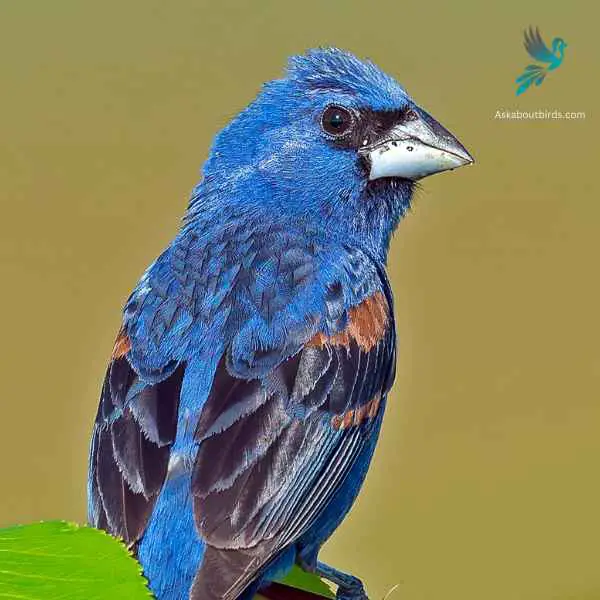
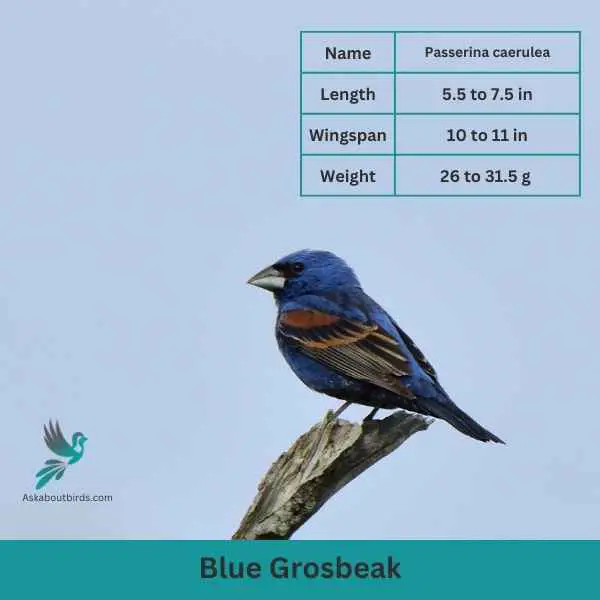
| Feature | Measurement |
|---|---|
| Scientific Name | Passerina caerulea |
| Length | 5.5 to 7.5 in |
| Wingspan | 10 to 11 in |
| Weight | 26 to 31.5 g |
The Blue Grosbeak is a medium-sized songbird found in North and Central America. The male Blue Grosbeak displays stunning plumage with deep blue feathers on its body and head, while the female has more subdued brownish tones. Both sexes have a thick, conical bill, which gives them their name “grosbeak,” meaning large beak.
These birds prefer open habitats such as grasslands, brushy areas, and woodland edges. Blue Grosbeaks are known for their melodious songs, which consist of a series of rich and varied notes. They primarily feed on seeds and insects, using their strong beaks to crack open seeds and forage on the ground or in low vegetation.
Blue-winged Warbler
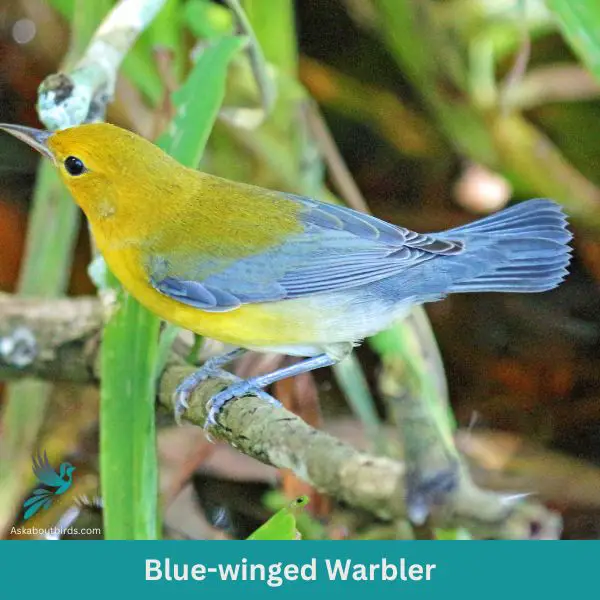
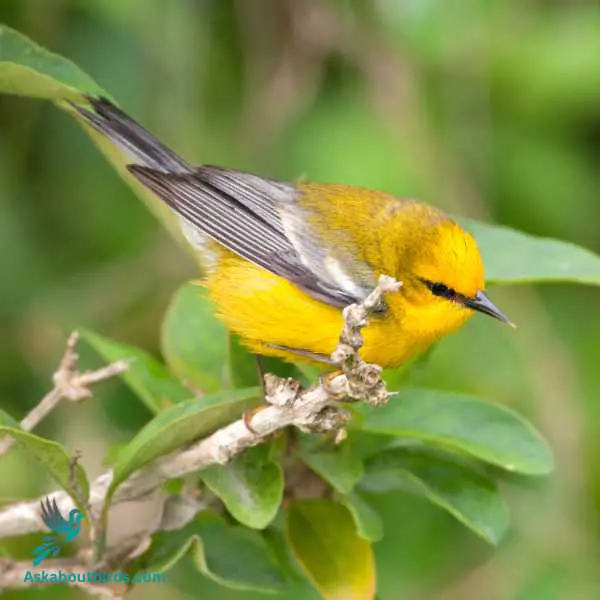
| Trait | Blue-winged Warbler |
|---|---|
| Scientific Name | Vermivora cyanoptera |
| Length | 4.3-4.7 inches |
| Wingspan | 6.7-7.5 inches |
| Weight | 0.3-0.4 ounces |
The Blue-winged Warbler is a vibrant songbird that stands out with its lemon-yellow coloring and buzzing song.
Appearance: This warbler displays a brilliant yellow body contrasted by blue-gray wings and a slim, black line through the eyes. The wings also feature two white wing bars.
Diet: The diet of the Blue-winged Warbler primarily consists of insects and spiders. They actively forage in shrubs and low trees, picking off their prey from the foliage.
Reproduction: Blue-winged Warblers build their nests on or near the ground, using grasses and other fine materials. The female lays a clutch of 4-6 eggs, which she incubates.
Cerulean Warbler
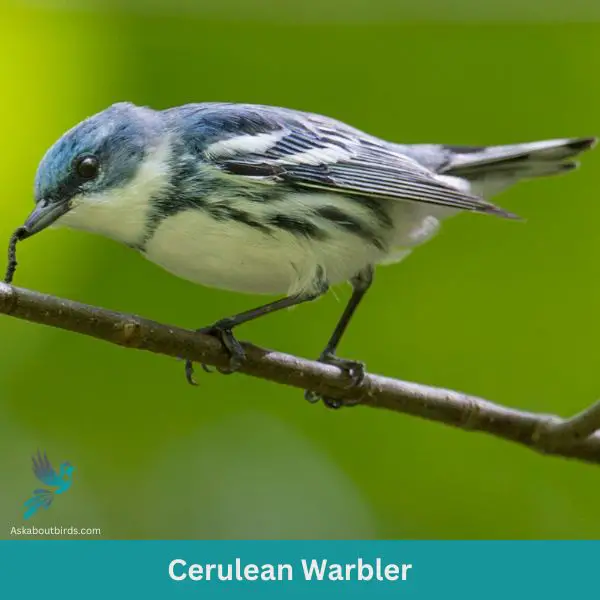
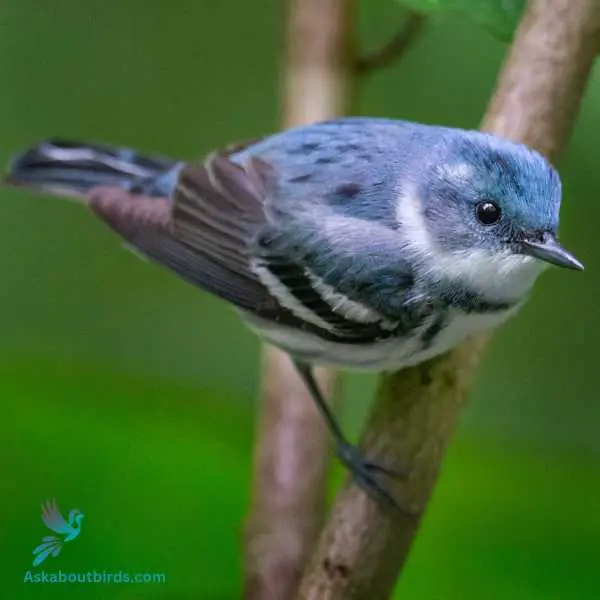
| Trait | Cerulean Warbler |
|---|---|
| Scientific Name | Setophaga cerulea |
| Length | 4.5 inches |
| Wingspan | 7.9-8.7 inches |
| Weight | 0.3-0.4 ounces |
The Cerulean Warbler is a striking songbird known for its sky-blue plumage and flitting movements in the forest canopy.
Appearance: Males boast a vibrant cerulean blue color on their upperparts, with streaked underparts, and a black necklace. Females have a more subdued bluish-green hue and lack the prominent black markings seen in males.
Diet: The diet of the Cerulean Warbler is predominantly made up of insects and spiders. They actively forage high in the treetops, gracefully maneuvering through leaves and branches.
Reproduction: Cerulean Warblers nest in the upper branches of tall deciduous trees. The female weaves a shallow cup-shaped nest and lays a clutch of 3-5 eggs.
Black-throated Blue Warbler
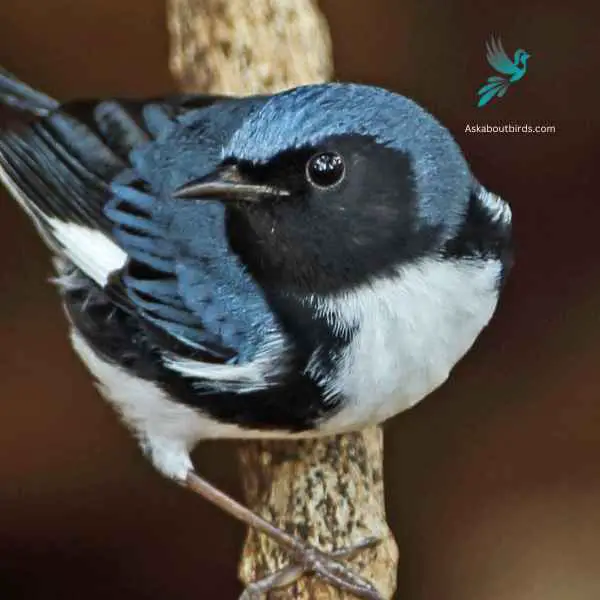
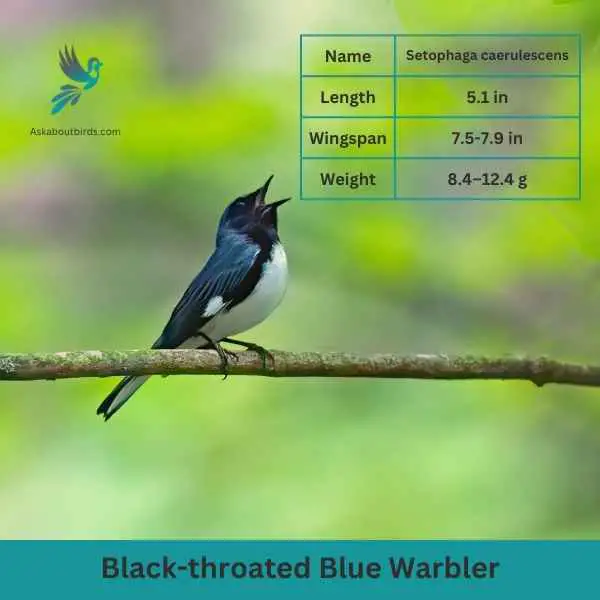
| Feature | Measurement |
|---|---|
| Scientific Name | Setophaga caerulescens |
| Length | 5.1 in |
| Wingspan | 7.5-7.9 in |
| Weight | 8.4–12.4 g |
The Black-throated Blue Warbler is a small migratory bird that breeds in the eastern United States and parts of Canada. The male Black-throated Blue Warbler displays a striking appearance with deep blue plumage on its upperparts, contrasting sharply with a black throat and a white belly. Females, on the other hand, have more muted colors, featuring grayish-olive plumage with a lighter throat.
These warblers prefer deciduous and mixed woodlands, where they forage actively for insects and spiders. They have a slender bill, which they use to extract prey from foliage and tree bark. During the breeding season, males perform courtship displays, showcasing their vibrant plumage and singing a high-pitched song to attract mates.
Black-throated Blue Warblers are known for their long-distance migration. They spend their winters in the Caribbean and Central America, where they inhabit various forested habitats. They construct cup-shaped nests in trees or shrubs, often placing them close to the ground.
Blue-gray Gnatcatcher
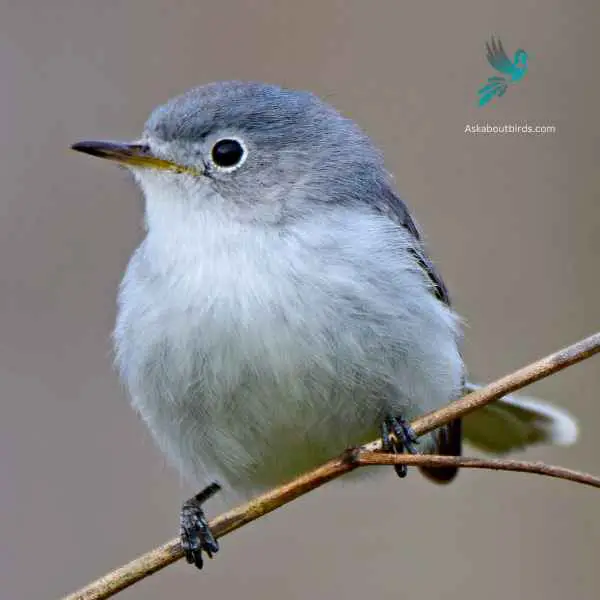
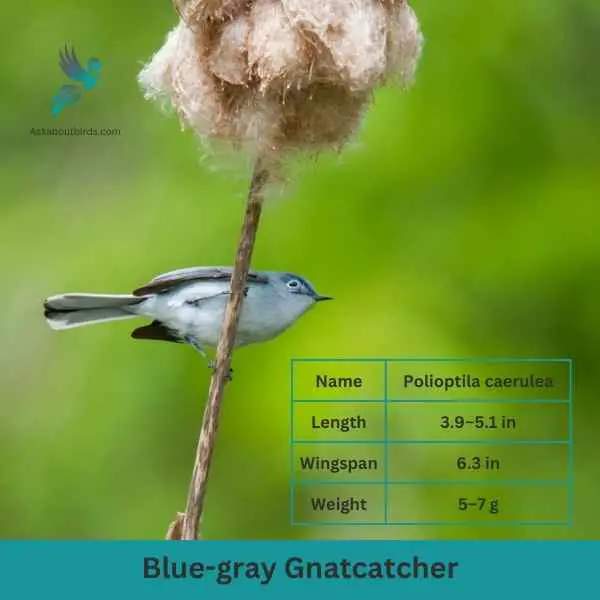
| Feature | Measurement |
|---|---|
| Scientific Name | Polioptila caerulea |
| Length | 3.9–5.1 in |
| Wingspan | 6.3 in |
| Weight | 5–7 g |
The Blue-gray Gnatcatcher is a petite, active bird, frequently observed flitting about treetops, emitting its distinctive high-pitched calls as it moves agilely through the branches.
Appearance: This bird exhibits a predominantly blue-gray plumage with a subtle white eye ring and long, slender tail feathers. The tail has distinctive black and white edging, with the males sometimes showing a faint black line on their forehead during the breeding season.
Diet: Blue-gray Gnatcatchers primarily feed on small insects and spiders. They’re adept hunters, foraging actively among foliage and even catching insects in mid-air.
Reproduction: These birds weave compact, cup-shaped nests on tree branches using plant materials, spider webs, and lichen. The exterior of the nest often matches the tree bark, making it well camouflaged. Inside, the female lays a clutch of 3 to 5 blue or greenish eggs, which she incubates.
Belted Kingfisher

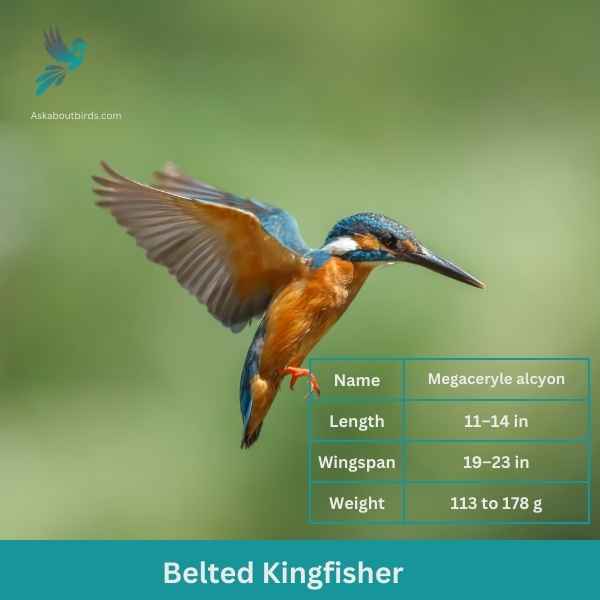
| Feature | Measurement |
|---|---|
| Scientific Name | Megaceryle alcyon |
| Length | 11–14 in |
| Wingspan | 19–23 in |
| Weight | 113 to 178 g |
The Belted Kingfisher is a distinctive and easily recognizable bird, frequently observed near water bodies, where it can be seen diving headfirst to catch prey.
Appearance: Sporting a prominent crest, the Belted Kingfisher has a slate blue-gray upper body and white underparts. Males possess a single blue band across their white chests, while females have an additional rufous band, making them one of the few bird species where females are more brightly colored than males. Their bill is long, sharp, and dagger-like.
Diet: As expert fishers, Belted Kingfishers mainly prey on small fish, but they’ll also consume crustaceans, insects, and amphibians. They’re known for their hunting tactic of hovering over water, spotting their prey, and then diving swiftly to snatch it.
Reproduction: Belted Kingfishers nest in burrows which they excavate in sandy or earthen banks, usually adjacent to water. The tunnel can be anywhere from 3 to 6 feet long, ending in a chamber. Within this chamber, the female lays a clutch of 5 to 8 white eggs.
Brown-Headed Cowbird
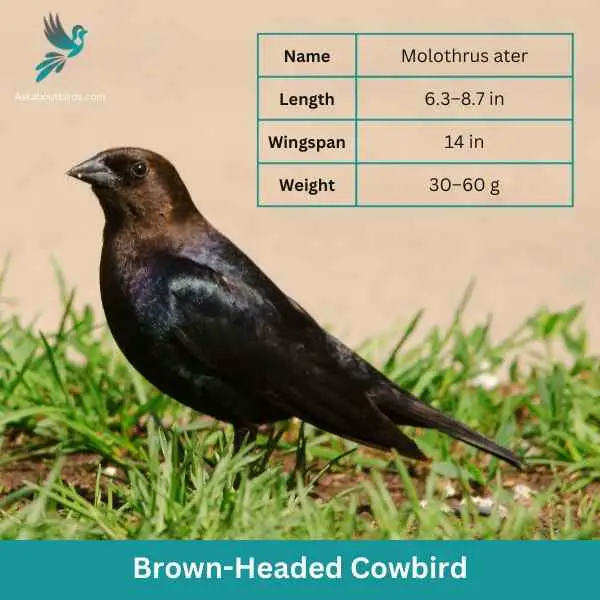
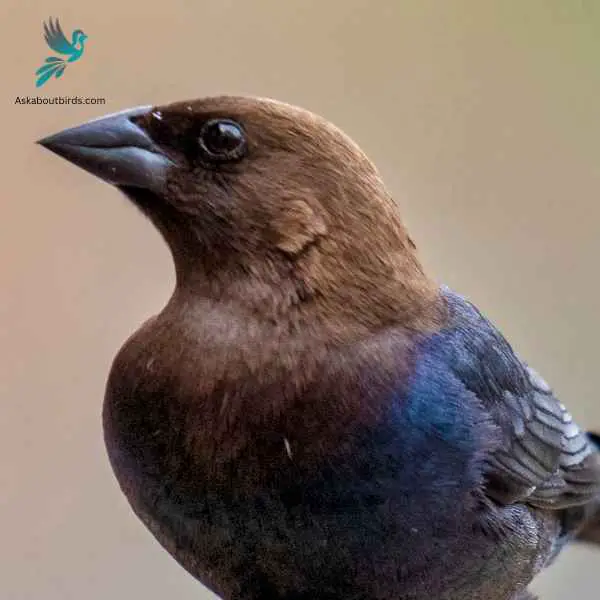
| Feature | Measurement |
|---|---|
| Scientific Name | Molothrus ater |
| Length | 6.3–8.7 in |
| Wingspan | 14 in |
| Weight | 30–60 g |
The Brown-Headed Cowbird is a unique North American bird known for its brood parasitism behavior. Rather than building its own nests, it lays its eggs in the nests of other bird species.
Appearance: Male Brown-Headed Cowbirds are glossy black with a distinct brown head, while females are plain gray-brown without the brown head. Both have a stout shape with a finch-like bill and a short tail.
Diet: Brown-Headed Cowbirds primarily feed on seeds, including grasses and grains. They also consume insects, especially during the breeding season. These birds often forage on the ground, commonly seen in open habitats like fields or pastures.
Reproduction: Unique among North American birds, the Brown-Headed Cowbird is a brood parasite. Instead of building its own nest, the female lays her eggs in the nests of other bird species. The unwitting host then raises the cowbird chick, often at the expense of its own offspring. The female can lay up to 40 eggs in a single breeding season, spread across multiple host nests.
Common Grackle
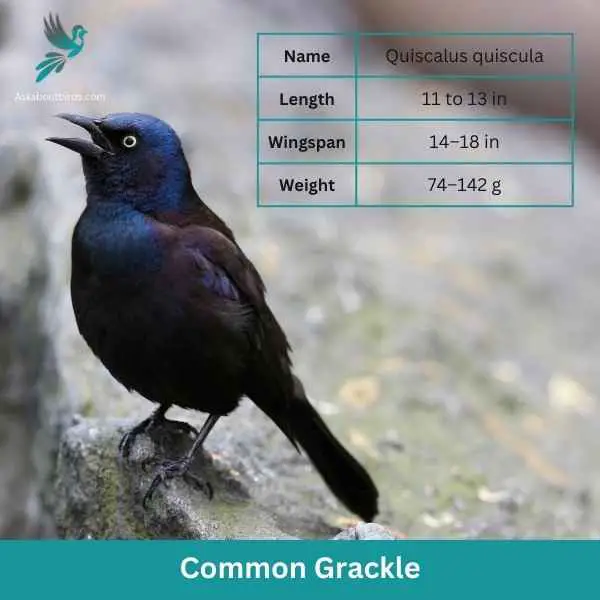
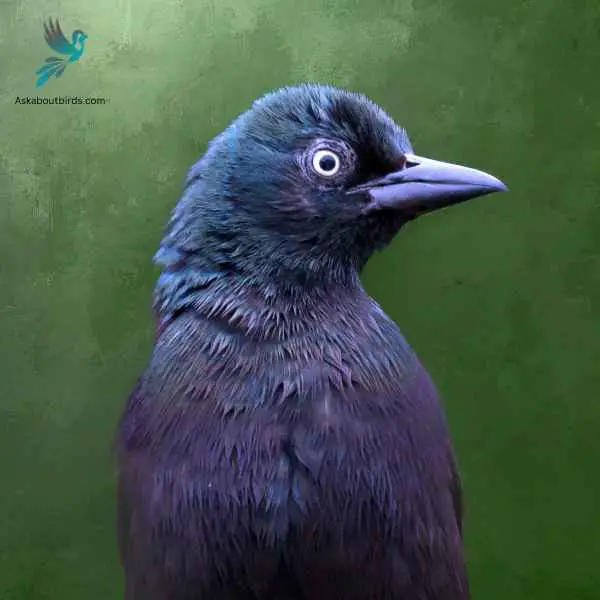
| Feature | Measurement |
|---|---|
| Scientific Name | Quiscalus quiscula |
| Length | 11 to 13 in |
| Wingspan | 14–18 in |
| Weight | 74–142 g |
The Common Grackle is a conspicuous bird found across much of North America, recognized for its glossy-black plumage, long tail, and piercing yellow eyes. Its vocalizations are varied and include a range of harsh, grating calls.
Appearance: The Common Grackle has a sleek black body with a glossy-iridescent sheen that can appear purple, green, or blue in certain lights. Its tail is long and keel-shaped. While both males and females have similar coloration, males are noticeably larger and shinier than females.
Diet: Common Grackles are omnivores. They primarily consume seeds, berries, and insects. However, they are also known to eat small fish, amphibians, and other birds’ eggs, especially when foraging on the ground or in shallow water.
Reproduction: Common Grackles breed in open and semi-open areas. The female typically selects the nest site and constructs a bulky nest made of grasses, twigs, and other plant materials, often in shrubs or trees. She lays a clutch of about 1 to 7 eggs, which are pale blue and spotted with brown.
Barn Swallow
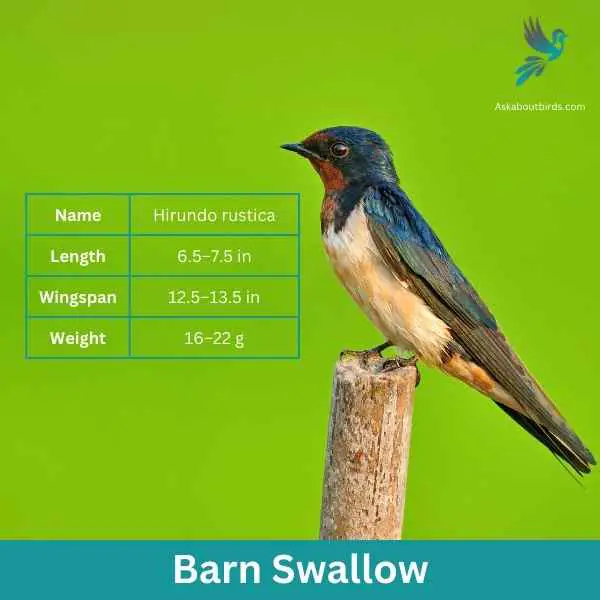

| Feature | Measurement |
|---|---|
| Scientific Name | Hirundo rustica |
| Length | 6.5–7.5 in |
| Wingspan | 12.5–13.5 in |
| Weight | 16–22 g |
The Barn Swallow is a sleek, agile bird renowned for its graceful flight patterns and iconic forked tail, often seen darting over fields and water bodies in search of flying insects.
Appearance: Barn Swallows have deep blue, almost iridescent, upperparts and a rufous to tawny underbelly. Their distinctively forked tail and long wings give them a streamlined look. Both males and females have a similar appearance, though males often exhibit slightly brighter colors and a deeper fork in the tail.
Diet: Barn Swallows feed primarily on flying insects, which they catch in mid-air during their agile and acrobatic flights. Their diet includes flies, beetles, moths, and other small flying insects.
Reproduction: Barn Swallows are known for building their mud nests on man-made structures, particularly barns, bridges, and eaves. The nest is cup-shaped and made from mud pellets, often lined with feathers. The female lays a clutch of 4 to 6 eggs.
Tree Swallow
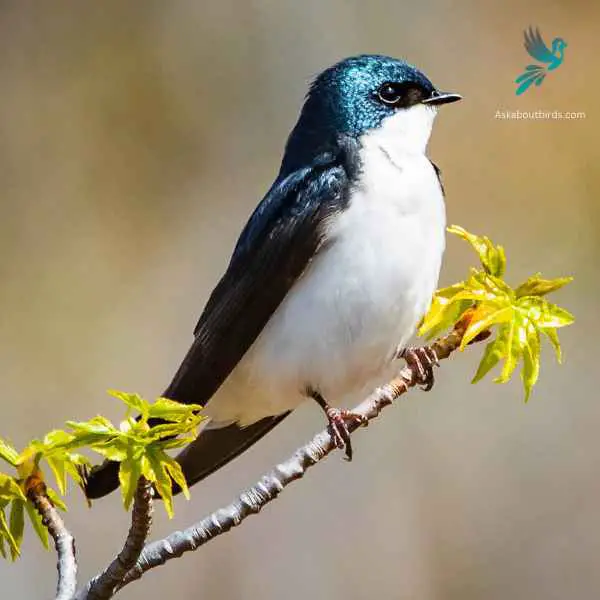
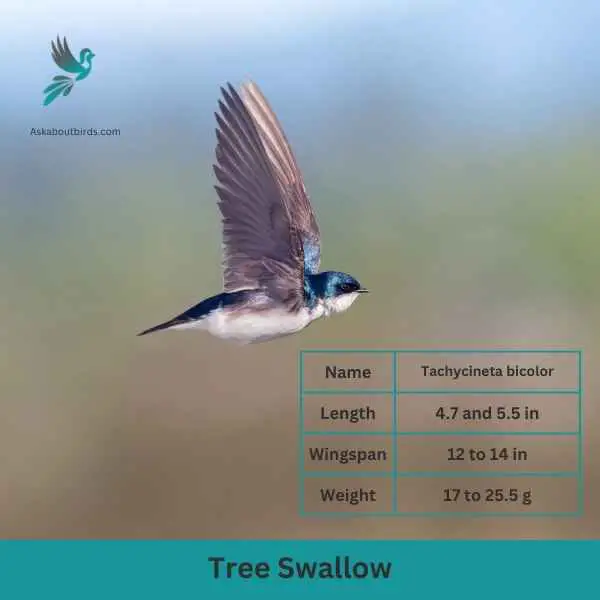
| Feature | Measurement |
|---|---|
| Scientific Name | Tachycineta bicolor |
| Length | 4.7 and 5.5 in |
| Wingspan | 12 to 14 in |
| Weight | 17 to 25.5 g |
The Tree Swallow is a graceful and agile bird, best recognized for its iridescent blue-green upperparts and sweeping flight patterns over open fields and water.
Appearance: The Tree Swallow is sleek with a streamlined body. The upperparts shine with a blue-green iridescence while the underparts are white. They possess long, pointed wings and a slightly forked tail, aiding in their agile flight.
Diet: Tree Swallows primarily feed on flying insects, skillfully catching them mid-air. During colder months when insects are scarce, they can switch to a diet of berries, particularly those of the bayberry, which other birds might find hard to digest.
Reproduction: Tree Swallows are cavity-nesters, typically choosing natural holes in trees or using bird boxes. They line their nests with feathers, creating a soft environment for the eggs. The female will lay a clutch of 4 to 7 white eggs.
Where to Spot Texas’ Blue Birds
The vast and diverse landscapes of Texas provide some of the best birdwatching opportunities in the United States. Here are some of the top locations in the state known for their incredible diversity of birds, including the stunning blue birds:
- High Island: Situated on the Gulf Coast, High Island is a renowned hotspot for birdwatching, especially during spring migration. The area’s woods and wetlands attract a wide variety of birds, making it an essential stop for birdwatchers.
- Big Bend National Park: Located in the Chihuahuan Desert, Big Bend National Park is home to more than 450 bird species, including several species of hummingbirds and the Colima warbler.
- Aransas National Wildlife Refuge: This coastal refuge is famous as the winter home of the endangered whooping crane. However, it also hosts a plethora of other bird species, including blue birds, throughout the year.
- South Padre Island: A barrier island on the Gulf Coast, South Padre Island is a critical stopover for migratory birds and offers excellent birdwatching opportunities, especially during the spring and fall migrations.
- Davis Mountains State Park: Located in West Texas, this park offers a unique blend of mountain and desert habitats that attract a wide range of bird species, including several that are typically found in more western regions.
| State’s Blue Birds | Best Spots for Blue Birds |
|---|---|
| Arkansas’s Blue Birds | 1. Hot Springs National Park 2. Buffalo National River 3. Holla Bend National Wildlife Refuge |
| Louisiana’s Blue Birds | 1. Barataria Preserve 2. Kisatchie National Forest 3. Sabine National Wildlife Refuge |
| Oklahoma’s Blue Birds | 1. Wichita Mountains Wildlife Refuge 2. Beavers Bend State Park 3. Oxley Nature Center |
| New Mexico’s Blue Birds | 1. Bosque del Apache National Wildlife Refuge 2. Sandia Mountains 3. Rattlesnake Springs |
FAQs on Blue Bird Species Found in Texas
How can I differentiate between different bluebird species?
There are three species of bluebirds found in North America: the Eastern Bluebird (Sialia sialis), the Western Bluebird (Sialia mexicana), or western bluebirds, and the Mountain Bluebird (Sialia currucoides). The Eastern Bluebird has a bright blue upper body, a red or orange chest, and a white belly. The Western Bluebird has a deep blue color on its head and back, an orange chest, and a gray belly. The Mountain Bluebird has a lighter, almost sky-blue color all over its body, and the females have a more subdued, grayish color.
How do bird feeders affect the breeding population of birds?
Bird feeders can have a positive impact on the breeding population of birds by providing a reliable food source during critical times, such as the breeding season when birds need extra energy to lay eggs and feed their young. A well-stocked bird feeder can attract a variety of birds, and in some cases, it can help increase the breeding population in your area. However, it is also important to be aware that bird feeders can sometimes attract unwanted visitors like European Starlings and House Sparrows, which are known to outcompete native birds for food and nesting sites. Therefore, it is essential to monitor the bird feeder regularly and take action if necessary, such as changing the type of food offered or installing a nest box for native birds.
What are the characteristics of brightly colored birds?
Brightly colored birds, such as the Indigo Bunting, are often adorned with vibrant feathers, which serve multiple purposes. The deep blue color of the Indigo Bunting, for example, is not due to pigment but rather the structure of the feathers which reflects light blue in a way that makes them appear blue. This brilliant plumage is often used to attract mates during the breeding season. Additionally, these colors can also serve as camouflage, helping the birds blend into their surroundings when needed. Other bluebird species, like the Eastern Bluebird, have a bright blue back and a reddish-brown throat and chest. Characteristics may vary among species, but these birds often have a medium size and a thin bill, and feed on insects and aquatic vegetation.
What kind of habitat do Purple Martins and Eastern Bluebirds prefer?
Purple Martins and Eastern Bluebirds prefer different types of habitats. Purple Martin is commonly found in the eastern half of the United States and prefers open areas with scattered trees or near water bodies, where they can easily catch insects. In the southern United States and western Texas, they tend to inhabit areas with aquatic vegetation. They usually nest in colonies and prefer nesting sites like gourds or multi-compartment birdhouses. Eastern Bluebirds, on the other hand, are found year-round throughout eastern North America and prefer open woodlands, farmlands, and orchards. They are cavity-nesting birds that prefer to nest in tree holes or nest boxes. They usually inhabit areas with deciduous forests, but they can also be found in other habitats with scattered trees. Both species eat insects and supplement with berries and fruits.

